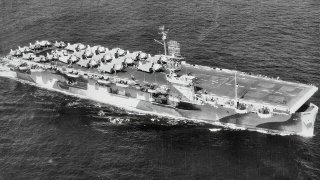USS Bismarck Sea: The Last U.S. Aircraft Carrier Lost in WWII
The USS Bismarck Sea (CVE-95) was a Casablanca-class escort carrier serving in the U.S. Navy during WWII. Commissioned in 1944, it played a vital role in the Pacific Theater, participating in the Philippines campaign, Iwo Jima landings, and Lingayen Gulf Operation.
Summary and What You Need to Know: The USS Bismarck Sea (CVE-95) was a Casablanca-class escort carrier serving in the U.S. Navy during WWII. Commissioned in 1944, it played a vital role in the Pacific Theater, participating in the Philippines campaign, Iwo Jima landings, and Lingayen Gulf Operation.
-The carrier had a range of 10,240 nautical miles, a top speed of 19 knots, and carried 28 aircraft.
-It was tragically sunk on February 21, 1945, by a kamikaze attack during the Battle of Iwo Jima, resulting in the loss of 318 crew members.
-Despite the loss, America's vast productive capacity mitigated its impact on the war effort.
Escort Carrier USS Bismarck Sea: A WWII Sacrifice in the Pacific
USS Bismarck Sea (CVE-95) was an escort aircraft carrier that served in the U.S. Navy during the Second World War. This boat was commissioned on May 20, 1944, and served until its tragic sinking on February 21, 1945, during the Battle of Iwo Jima.
In WWII, the Navy had countless warships. The loss of a carrier was nowhere near as catastrophic as the loss of an American nuclear-powered carrier would be today.
Specifications on This 'Escort' Aircraft Carrier
Bismarck Sea belonged to the Casablanca-class escort carrier, a type of small aircraft carrier built for the Navy during World War II. These carriers were designed to protect convoys of merchant ships from enemy submarines and aircraft.
USS Bismarck Sea had a range of approximately 10,240 nautical miles and a top speed of 19 knots. The range allowed the carrier to operate effectively in the vast Pacific Theater of World War II, conducting patrols and engaging in combat operations far from friendly bases.
The Pacific Theater was fought over extreme distances, greatly straining the technology of the era. Platforms such as the Balao-class submarine or the Navy’s various carriers ensured that distance was not as significant of a factor as it might have been.
Today, nuclear-powered carriers and subs overcome the quandary of distance because of their technical capabilities (they don’t need to be constantly refueled). Of course, they’re more complex and expensive. And they’re poorly defended against the threat of anti-ship ballistic missiles. Back in WWII, these systems were vulnerable as well.
But they were more expendable than are America’s carriers today.
Bismarck Sea had a crew of approximately 860 officers and enlisted men. This relatively large crew allowed the carrier to operate effectively for extended periods at sea, conducting patrols and engaging in combat operations. This boat carried a complement of 28 aircraft, including sixteen FM-2 fighters and twelve TBM-1C Avenger torpedo bombers. These aircraft were used for a variety of missions, including air defense, anti-submarine warfare, and ground attack.
The History of the Bismarck Sea
USS Bismarck Sea took part in several historic battles during its brief service life. It supported the Philippines campaign, the landings on Iwo Jima, and the Lingayen Gulf Operation. These missions were crucial to the Allied advance in the Pacific Theater and the eventual defeat of Japan.
Tragically, USS Bismarck Sea was the last American naval vessel lost in World War II. On February 21, 1945, the carrier was attacked by a swarm of Japanese aircraft off the coast of Iwo Jima. Despite the damaging gunfire from the carrier’s anti-aircraft guns, two Japanese planes managed to crash into the ship, causing a series of explosions and fires that quickly raged out of control.
Overcoming the Loss
USS Bismarck Sea sank within two hours of the attack, taking 318 crewmembers with it. If the United States lost an aircraft carrier today, it would be a major blow to America’s morale and it would create a considerable gap in the strategic defenses of the United States. Back in WWII, it was just the cost of doing business.
America’s productive capacity was so great that the loss had little impact on the overall war effort, or on America’s ability to serve as the “arsenal of democracy.”
Under present conditions, the world is rapidly entering a third world war—and the fighting will be felt across every domain, including the sea. America’s modern aircraft carriers are more vulnerable than they have been since the Second World War.
Author Experience and Expertise: Brandon J. Weichert
Brandon J. Weichert, a National Interest national security analyst, is a former Congressional staffer and geopolitical analyst who is a contributor at The Washington Times, the Asia Times, and The-Pipeline. He is the author of Winning Space: How America Remains a Superpower, Biohacked: China’s Race to Control Life, and The Shadow War: Iran’s Quest for Supremacy. His next book, A Disaster of Our Own Making: How the West Lost Ukraine, is due October 22 from Encounter Books. Weichert can be followed via Twitter @WeTheBrandon.
All images are Creative Commons or Shutterstock.
From the Vault
Russia Freaked Out: Why the U.S. Navy 'Unretired' the Iowa-Class Battleships
Battleship vs. Battlecruiser: Iowa-Class vs. Russia's Kirov-Class (Who Wins?)


